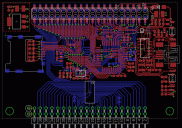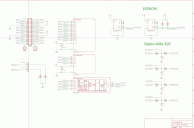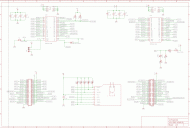QuickStart compatible cpu board Prime
 ErNa
Posts: 1,742
ErNa
Posts: 1,742
New Year, next board. As it will take some time to have a P2, there is a board containing two P1 and an additional XMC Cortex M0. This board contains a propeller on top and bottom, those are daisy-chained. The XMC 1100 serves as flash memory to boot and gives some more extras like ADC's and I/O-pins
State of the project: components are ordered, after verification of all dimensions and space restrictions, there will be a few prototypes to see if the expectations are met.
State of the project: components are ordered, after verification of all dimensions and space restrictions, there will be a few prototypes to see if the expectations are met.








Comments
Thanks!
Looks nice!
What was the motivation for using the Cortex-M0? Us armchair designers might have gone for an STM32 F4 for it's floating point capability.
If you have an ARM and and a Prop on the same board why not just have the ARM download code to the Prop on boot up with the normal serial protocol.
In my mind the ARM would boot the Propeller with whatever firmware is required to do the job.
No EEPROM required.
It depends on your external hardware, which ARM, and what high-level logic is needed.
If...
your external hardware is a bunch of analog values that need to be converted and some I2C or SPI chips
your ARM is a Cortex-M
and your high-level logic doesn't include floating point and/or requires some serious parallelism...
then the Propeller will make a far better master than the ARM.
If...
your external hardware is a custom protocol serial bus or an input pin that requires a fast response
your ARM is an M4F or better (more powerful than Cortex-M series)
and your high-level logic includes floating point or something else that an 80 MHz propeller can't handle...
then the ARM makes a better master.
Does it really matter, and is it really necessary to designate a dog and a tail? Why not have each one do what it does best. Something along the lines of co-routines, where propeller performs it's functions and functions requested by arm, and arm does its functions and those requested by propeller.
It's just that my ARM machines run Linux and have internet connections.
A Propeller is a peripheral to all that.
Yes, using the propeller as the tail and a PC, Odroid, or Pi as the dog is pretty typical, but it doesn't always have to be that way. Now that arm chips have multiple cores it might be advantageous to offload things like floating point calculations or table lookups to a dedicated core.